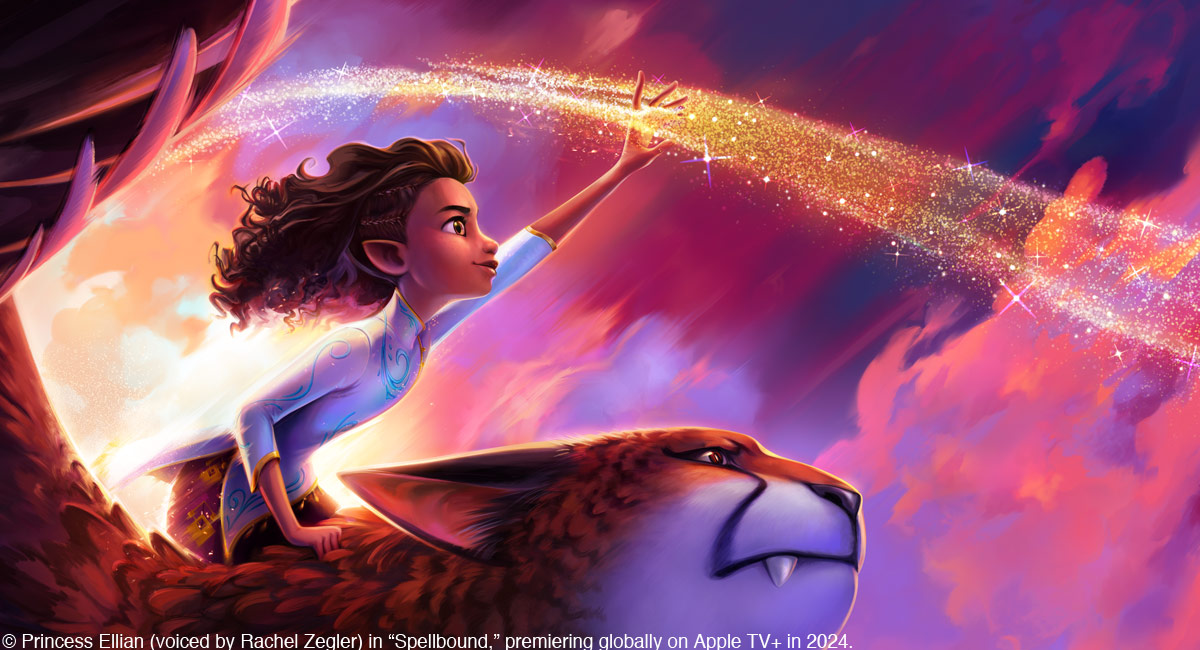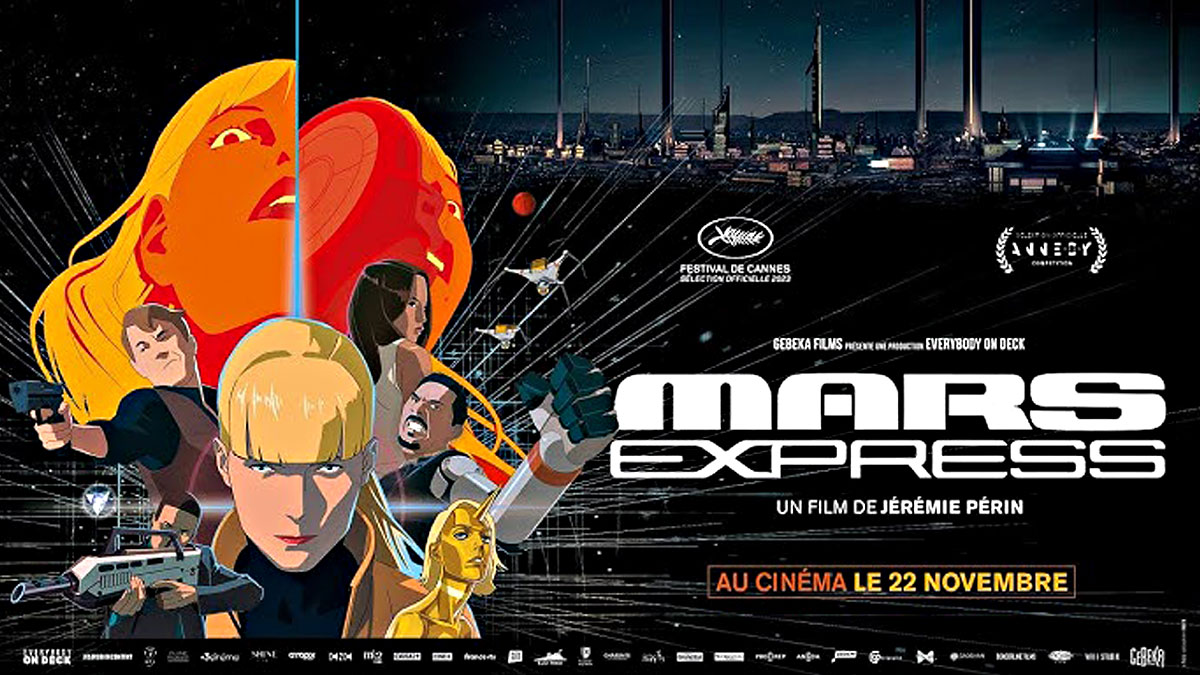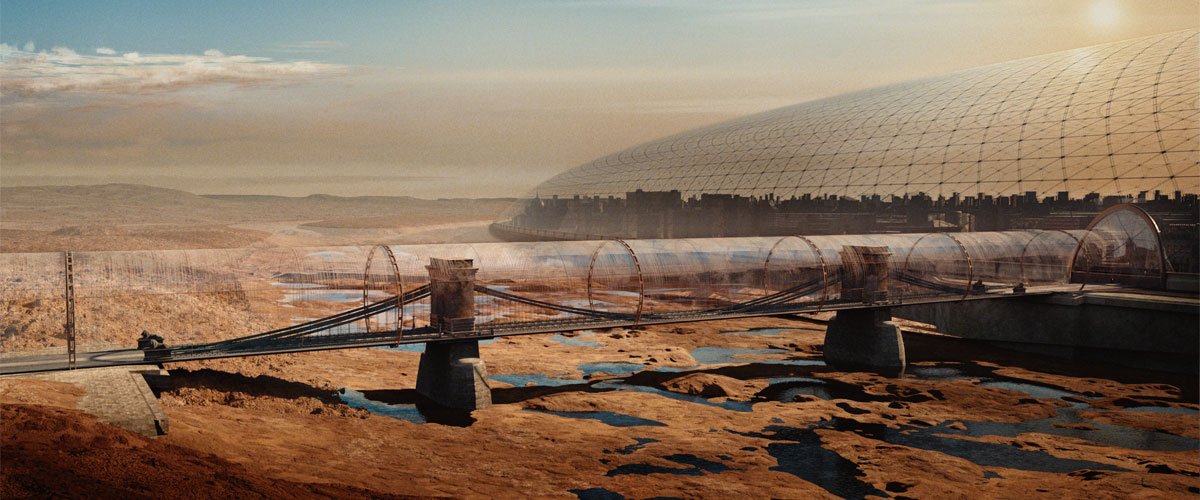Spellbound is an Apple Original Film by Skydance Animation that will be released on Apple TV+ next year. The 3DCGI film is being developed by a dream team:
Director:
– Vicky Jenson (Shrek (2021))
Authors:
– Linda Woolverton (Beauty and the Beast (1991), The Lion King (1994), Mulan(1998), and Alice in Wonderland (2010))
– Lauren Hynek (Mulan (2020))
– Elizabeth Martin (Mulan (2020))
Song composer:
– Alan Menken (The Little Mermaid (1989), Beauty and the Beast (1991), Aladdin (1992), and Tangled (2010))
Song lyrics:
– Glenn Slater (Tangled (2010))
Producers:
– John Lasseter
– David Ellison
– Dana Goldberg
– Bruce Anderson

Spellbound is a story set in the kingdom of Lumbria, where the princess Ellian embarks on her great journey to save her family and kingdom after a mysterious spell transforms her parents into monsters and threatens to cover the kingdom in darkness forever.
The Annecy International Animation Film Festival 2023 set a special talk session with the director Vicky Jenson and the head of story Brian Pimental as a Work in Progress session for Spellbound. They talked about a variety of precious stories behind the film project, such as the story, characters, visuals, and music.
We interviewed Vicky and Brian on the fascinating story behind Spellbound after the Work in Progress panel.
Interview with Vicky Jenson and Brian Pimental
Animationweek (AW): How did you take part in this film project, and what aspects of the film project has led you to that decision?
Vicky Jenson: I was interviewed at Skydance at the end of 2017, and I was pitched the basic idea of the story by David Ellison and Dana Goldberg, and I was immediately drawn to the meaning of the story, and the strength of that meaning.
Brian Pimental: I came shortly after I was called into Skydance, met Vicky and we’ve connected on it, especially the fact that there’s going to be a musical was really exciting to me.
Vicky Jenson: Brian was the storyboard artist for “Be Our Guest” and “Human Again” on Beauty and the Beast. That’s his superpower, so we needed Brian like crazy for this movie.
AW: What were your first impressions on the original story written by Linda, Lauren, and Elizabeth?
Vicky Jenson: That script was definitely on an epic scale, and when we started getting into the story and John Lasseter came in, we whittled it down to the core idea, the strong emotional story. We took some of those huge aspects of it and we put them up on a shelf while we focus on what the movie was about, which had a lot of magic. A lot of cool ideas, but a lot to work with, and so little-by-little we put a few things back in that’s most important to the story.
AW: What aspects do you take care in the most when developing the film’s script overall? How are you adapting the original story to the film format?
Brian Pimental: I think the outsider’s perception in animation is that we have a script and then we just do it, but that’s not the case. For us, we have to take the script and keep rewriting it with the storyboards. We’ve been on this for six years and you have writers and story artists come and go whilst bringing something into it, but the emotional story is the core, and constantly through every version you’re trying to embellish that.
Vicky Jenson: What’s different about animation is that it’s an evolution. In live-action you keep rewriting the script until everybody’s happy and then shooting starts, but they always say there’s one story that you write, one that you shoot, and one that you edit. For us, it’s the same way when you have a script: it’s the first ideas as we draw them, and then they grow and evolve. You realize, for instance, that as you draw things, that less is dialogue and more is visual: maybe the characters can use action instead of dialogue. So, all of this is an evolution.
AW: What was your main inspiration for the design of the environment, and the stylistic direction of the film’s visual universe in general?
Vicky Jenson: Since the story originated really from Spain, our company Skydance developed these ideas. When I came on the project, the early artwork was very European, like a fairy tale from Ireland, England or Scandinavia, and I thought “Let’s use Spain!”, with its beautiful architecture and artwork. So, we started there and we built our fantasy look off of those motifs, which I think a lot of people haven’t seen before. So, it gave us something really beautiful to start with.
AW: What was your process in developing the character designs, and what aspects did you take care in the most?
Vicky Jenson: We brought down an amazing character designer: Guillermo Ramírez. A young man who designed virtually every character in the movie. He was on very early and we were just looking for a strong appeal for the characters. Not super photoreal, but we all loved where we came from: two-dimensional, hand-drawn animation, and so we let some of those aesthetics drive the design of the characters. Beautiful and very strong silhouettes to the characters, and their personalities were key to come across in the design; the way the monsters were designed to reflect who they were as humans.
AW: What was it like communicating with the character designers? I would like to hear how you share your vision or idea to the creators.
Vicky Jenson: The story has to drive everything. So, we talk about the story, we pull out our pens and we start drawing things. Brian gathered a lot of beautiful photographs of creatures, and I made a very simple Sharpie drawing of monster mom on a Post-It note!
We all like strong shape language, I guess is how you would put it, and that comes from hand-drawn design where you think about the strong shapes, like how the father might be more square and the mother’s more round, just as a way of starting.
AW: The musical parts of the film really illuminate the characters’ internal journey. Brian, how do you storyboard the musical parts of the film? What is your process?
Brian Pimental: It’s always starting with the music and really, really listening to it, and then looking for ways to illustrate the emotional quality that I’m trying to tell throughout. The lyrics, of course, are going to guide you along the way, and push you along the direction as to what you should actually show. There was a scene about Ellian’s memories on the life she had before, so I would come up with ideas that I can remember, either my family or other people in our crew, and what did they do with their families, and so that became her past. And then it just evolves. You share that with the director and the producer, and they react, and you change some things to try to make it stronger, and you just keep building from there.
AW: The musical parts seem to have layers of meaning, not only following the lyrics but also the key emotional moments from the characters, so how did you manage to fit all that information whilst keeping it easily understandable for the audience?
Brian Pimental: As I work, I look for imagery that sums up what’s going on. For example, in the scene where the painting is upside-down that fell off the wall, that’s like her life, now that her parents are monsters. The reflection in the water showing it right-side up is showing what life used to be, but the reflection is still blurry, like a memory. I was playing with those kind of concepts, even the music felt very haunting. So, to me, it was very ghost-like, almost like a haunted house, and I was playing with those ideas in the beginning, and a little bit here-and-there. I think they’re always looking for a visual symbol to hit the idea.
I think it just comes, and it doesn’t come all at once, and it’s a long period of finessing and finding better ones, and replacing ones that aren’t as good.
AW: What kinds of creative difficulties have you faced during this project, and how did you overcome them?
Vicky Jenson: There were always difficulties in figuring out how to tell the story and have it come across. The story is unique and there’s a special aspect to it, so just the story itself is a challenge and during development you find yourself in these pendulum swings, where one way the story will feel much too sad, then you overcorrect and now the story is too silly and it doesn’t feel important anymore.
All the way through you’re trying to find the right balance between truth, emotions, humour, entertainment and action, but it all serves what the movie is all about, and it’s not easy. It’s never easy. It just takes time to find the right way to have it come across.
We show the movie to our friends, to our family, to the crew, to the crew of the other movies at the studio, just to keep testing their reactions. So, that’s one way we overcome some of those bigger challenges of working on one story for so long.
Brian Pimental: I remember Ellian being challenging for a long time, having to keep getting her a distinct personality. She was kind of vague, and then it took a while keep finding and changing and trying different ideas, like whether she’s a tomboy, or she’s super-optimistic, you know, what are the things can we do? So, as we go through it, you get this piece right, and then you can get that piece right, and then you might have several pieces that are working. But when you watch the whole thing, it’s not playing right, and you have to keep balancing it, you will maybe need less of that, and more of this. It’s like clay: you’re constantly reshaping it.
AW: What was it like working with the musician Alan Menken and lyricist Glenn Slater?
Vicky Jenson: They were amazing. We got to do a retreat with just us, John Lasseter, and our writers Lauren Hynek and Elizabeth Martin, who wrote Mulan. We spent four days talking about the story, having Alan Menken playing some ideas for us, entertaining us with songs from other movies. It was just like having a masterclass from the two of them as well as learning about musicals from producer Chris Montan, since I never worked on a musical before. It’s very unique how songs keep the story moving forward and elevate emotions. It was a marvellous experience!
Brian Pimental: While I thought I knew about music, they would always guide us through it. They would say, for instance, “the song isn’t going to work because the story is not giving us the setup for it”, and we would go change the story, and as the stories changed, the songs had to change, too. We had to go back and forth with this over several years. We had one song, My Parents are Monsters, and we had to rewrite it like five times, as it had to be closer to the theme.
It’s like getting a tennis ball back. A lot of times you end up missing the ball!





